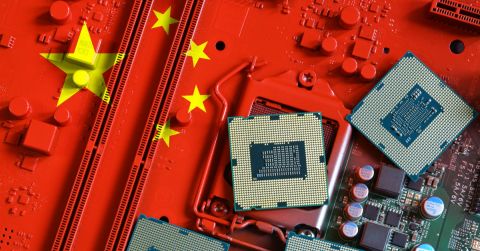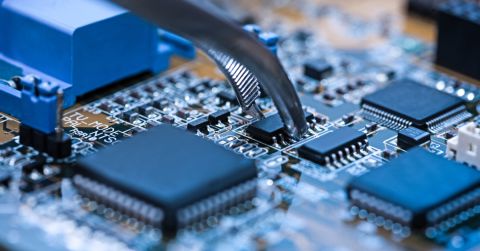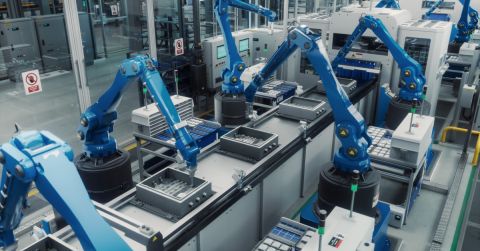What Is Allocation in the Semiconductor Industry?
As I sat across from a C-level executive from one of the leading semiconductor firms during my time interviewing industry leaders for Supply Chain Digital and Manufacturing Global magazines, I vaguely remember him saying something along the lines of, "The semiconductor industry is like the weather—foreseeable to an extent, but filled with sudden storms that can change everything." That’s probably not verbatim, and I believe he was repeating it from another, but regardless… That insight rings truer today than ever before.
A Brief Journey Through Time
The semiconductor industry, originating in the mid-20th century, has exponentially advanced from inventing transistors to developing integrated circuits, microprocessors, and personal computers. This growth results not only from technological progress but also from the interplay of geopolitics, economic policies, and environmental challenges, causing significant shifts, especially in the past decade.
Post-Covid-19, the industry grappled with increased demand from the consumer electronics and automobile sectors amidst disrupted supply chains due to lockdowns, labor shortages, and logistical issues. Geopolitical tensions, trade wars, and nationalistic policies added strain, as countries recognized semiconductors' strategic importance, leading to stricter regulations and sometimes bans on trading key equipment and technology. Environmental challenges, like severe droughts in major hubs like Taiwan, further complicated the situation.
Diving into ‘Allocation’
Amidst this chaotic backdrop emerges the concept of 'allocation'. In layman's terms, allocation in the semiconductor industry refers to the method manufacturers use to distribute their limited supply of chips to various customers when demand exceeds supply. Instead of a free market scenario where companies can order as many chips as they need, manufacturers begin to ration their output.
Allocation can be based on various factors:
- Historical purchasing patterns: Long-term, loyal customers might receive preferential treatment.
- Strategic importance: Customers producing essential products over extended time periods may take precedence.
- Contractual obligations: Some contracts may have clauses that protect certain customers during shortages.
The immediate effects of allocation are obvious: a slowdown in product releases, increased costs, and potential layoffs in sectors heavily reliant on semiconductors.
In the long run, allocation can lead to:
- Reconsideration of just-in-time (JIT) models: Companies may begin to stockpile, leading to increased inventory costs.
- Rethinking supply chains: Companies might consider nearshoring or reshoring to ensure more control over their supply.
- Innovation in alternate materials: The search for alternatives to silicon might gain momentum.
- Strategic partnerships and mergers: Firms may look for mergers or collaborations to ensure a steady supply.
How can you ensure you’re a candidate for allocation? This is a matter of purchasing volume and building a relationship with the semiconductor manufacturer. Generally, when you are purchasing at higher volume, you will not be working with electronic parts distributors. Instead, you will buy directly from the manufacturer. After consistent purchasing over time, a buyer will have a chance to build a deeper relationship with the supplier and they will have a greater chance to receive allocation.
The fastest way to gain allocation is to enter into a periodic purchase agreement with the semiconductor vendor. This normally involves signing an LOI for periodic purchases at quantity, as well as prior agreed-upon payment arrangements, but even that might not guarantee allocation when demand is excessive. The higher your periodic purchase volume, the easier it will be to get allocation when supplies get tight.
Some semiconductor manufacturers have online portals that give buyers direct access to inventory and an account management team. Some of the best known companies offering this level of access are Texas Instruments, Microchip, and Analog Devices. When you’re searching for inventory online, you’ll be able to see the inventory these manufacturers are holding and offering for sale to the public. If you start making high volume purchases from these sites, an account management team member will notice and you can start expecting phone calls from them.

Going beyond a manufacturer’s website, you can try reaching out to the company directly for volume orders. Another option is to find an account manager in your region on LinkedIn as they are very likely to respond to cold requests for volume purchases.
Looking Forward: The Industry’s Roadmap
As with all challenges, the semiconductor conundrum is also pushing the industry, governments, and stakeholders to rethink, reimagine, and reinvent. Now, an update with data sourced from SEMI and TechInsights’ recent Semiconductor Manufacturing Monitor.
The whisper of recovery is growing louder, with a forecasted rebound by 2024, following a moderation in the decline of IC sales. The scenario in Q3 2023 looks promising, with electronics sales alongside memory IC and Logic IC sales showing a positive trajectory. However, the specter of high inventory levels continues to loom large, suppressing fab utilization rates and extending declines in capital equipment billings and silicon shipments through the rest of 2031.
The narrative of sequential IC sales declines seems to be shifting, hinting at a gradual recovery as we approach 2024. The figures in Q3 2023 are encouraging, with electronics sales projected to post a healthy quarter-on-quarter growth of 10% and memory IC sales expected to see double-digit growth, a first since the downturn began in Q3 2022. Logic IC sales are holding steady, poised to improve as demand gradually picks up.
However, the hurdles aren’t behind us just yet, especially in the latter half of 2023. High inventory levels at integrated device manufacturers (IDM) and fabless companies continue to be a challenge, keeping fab utilization rates lower than desirable. This trend is likely to extend the declines in capital equipment billings and silicon shipments for the rest of the year despite stable results in the first half.
As we transition into 2024, the industry seems poised for a rebound, with all segments projected to log year-over-year increases and electronics sales are expected to surpass its 2022 peak.
Clark Tseng, Senior Director of Market Intelligence at SEMI, notes a slower-than-expected demand recovery, pushing the normalization of inventory to the end of 2023. However, recent trends suggest a potential bottoming out in Q1 2024, painting a cautiously optimistic picture for the industry.
Despite a sharp downturn in semiconductor markets over the last four quarters, equipment sales and fab construction have performed better than expected, thanks to government incentives driving new fab projects and strong backlogs supporting equipment sales.
The Semiconductor Manufacturing Monitor (SMM) report, a collaborative effort between SEMI and TechInsights, provides comprehensive data on the worldwide semiconductor manufacturing industry. It highlights key trends, including capital equipment, fab capacity, and semiconductor and electronics sales, offering a glimpse into the industry’s roadmap.
Investment in Infrastructure: Recognizing the strategic importance, nations worldwide are ramping up their semiconductor manufacturing capacities. The aim? To reduce dependencies on a few key players and regions. Massive investments are being funneled to develop state-of-the-art fabs and research facilities.
Policy Changes: Governments are not just passive observers. From tax incentives to foster local production to strategic trade alliances ensuring a smoother flow of semiconductor goods, policy frameworks are being redefined.
Technological Breakthroughs: The crisis has also fast-tracked research into alternatives. Whether it's diving deeper into quantum computing, exploring the potential of neuromorphic chips, or even revisiting the material basics of semiconductors, the industry is on the brink of potentially groundbreaking innovations.
The road ahead might be challenging, but it's also ripe with possibilities.
The Takeaway: What It Means For You
For the average consumer, the semiconductor crunch might feel distant, but its repercussions are closer than you think.
- Gadget Prices: With supply constraints, the cost to manufacture devices goes up, and these increases often get passed down to consumers.
- Availability: That next-gen smartphone or gaming console might see its launch delayed or might be available in limited quantities, leading to potential waiting periods. (This is not too dissimilar to the PlayStation 5 shortage that we witnessed between late 2020 and early 2023.)
- Features: Companies, in a bid to manage their semiconductor use, might release devices with fewer features or functionalities. That advanced AI feature or enhanced battery life promised in the next tech device might just be postponed to the subsequent version.
But it's not all doom and gloom. This crisis also pushes companies to innovate faster, optimize better, and potentially bring forward the next big tech revolution, so while there might be temporary setbacks, the future, as always, holds promise.
The semiconductor industry, the bedrock of the modern digital age, is undergoing one of its most challenging phases. As manufacturers grapple with allocation, its ripple effects will be felt across industries and continents. However, history has shown that such challenges also spur innovation, collaboration, and resilience. As I reminisced about my interviews, it struck me that the semiconductor industry, in its journey, reflects the human spirit—constantly evolving, adapting, and pushing the boundaries of what's possible.









